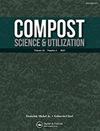评价堆肥中大麦醪与木屑的比例对微生物处理速率和随后的蔬菜产量的影响
IF 0.9
4区 农林科学
Q3 ECOLOGY
引用次数: 8
摘要
摘要食物垃圾堆肥与城市农业相结合,为增加城市生态系统中的营养循环提供了机会。限制好氧食物垃圾堆肥扩展的一个潜在制约因素是富含碳的难降解材料的可用性,如木屑。我们测量了大麦泥和木屑的不同混合物在整个堆肥生命周期中营养保留的差异,以评估使用按比例减少的木屑堆肥是否会导致更高的营养回收率。九个堆肥堆(1m3)以不同比例构建,大麦泥与木屑的比例从10:90到90:10不等。在堆肥过程中,50:50的混合物将内部温度保持在55°C以上30天,随着混合物向任何一个方向分化,温度都会下降。在接下来的3个月里,食物垃圾含量与内部水分和CO2呈正相关,与内部O2呈负相关。第二年夏天,完成的堆肥被用在花园里的凸起的床上。芝麻菜和番茄的产量随着堆肥大麦泥含量的增加而增加,在高水平下饱和。在所有处理中,<5%的N和<2%的P从大麦泥中回收到新的蔬菜生产中。尽管使用高大麦泥堆肥回收了最大量的营养物质,但与中间混合物相比,这些处理的营养物质回收效率也较低。这些结果表明,在堆肥中使用木屑可以提高食物垃圾中营养物质的保留效率,进而增强城市环境中的营养物质回收利用。本文章由计算机程序翻译,如有差异,请以英文原文为准。
Assessing How the Ratio of Barley Mash to Wood Chips in Compost Affects Rates of Microbial Processing and Subsequent Vegetable Yield
ABSTRACT The composting of food waste coupled with urban agriculture presents an opportunity to increase nutrient recycling in urban ecosystems. One potential constraint limiting the expansion of aerobic food waste composting is the availability of carbon-rich recalcitrant materials, such as wood chips. We measured the differences in nutrient retention throughout the compost life cycle for different mixtures of barley mash to wood chips, to assess whether composting using proportionally less wood chips would lead to higher nutrient recycling rates. Nine compost piles (1 m3) were constructed at varying ratios barley mash to wood chips, ranging from 10:90 to 90:10. During the composting process, the 50:50 mixture maintained internal temperatures above 55°C for 30 days, with drop-offs as mixtures diverged in either direction. Food waste content was positively related to internal moisture and CO2, and negatively related to internal O2, throughout the ensuing 3 months. The finished compost was used in raised-bed garden plots during the following summer. Yields of arugula and tomatoes increased with compost barley mash content, saturating at high levels. Across all treatments, <5% of N and <2% of P were recycled from barley mash into new vegetable production. Although the maximum amount of nutrients was recycled using high barley mash compost, these treatments also had lower nutrient recycling efficiency compared to intermediate mixtures. These results indicate that the use of wood chips in composting increases the efficiency nutrient retention from food waste and in turn enhances nutrient recycling in urban environments.
求助全文
通过发布文献求助,成功后即可免费获取论文全文。
去求助
来源期刊

Compost Science & Utilization
农林科学-生态学
CiteScore
4.10
自引率
0.00%
发文量
0
审稿时长
>36 weeks
期刊介绍:
4 issues per year
Compost Science & Utilization is currently abstracted/indexed in: CABI Agriculture & Environment Abstracts, CSA Biotechnology and Environmental Engineering Abstracts, EBSCOhost Abstracts, Elsevier Compendex and GEOBASE Abstracts, PubMed, ProQuest Science Abstracts, and Thomson Reuters Biological Abstracts and Science Citation Index
 求助内容:
求助内容: 应助结果提醒方式:
应助结果提醒方式:


